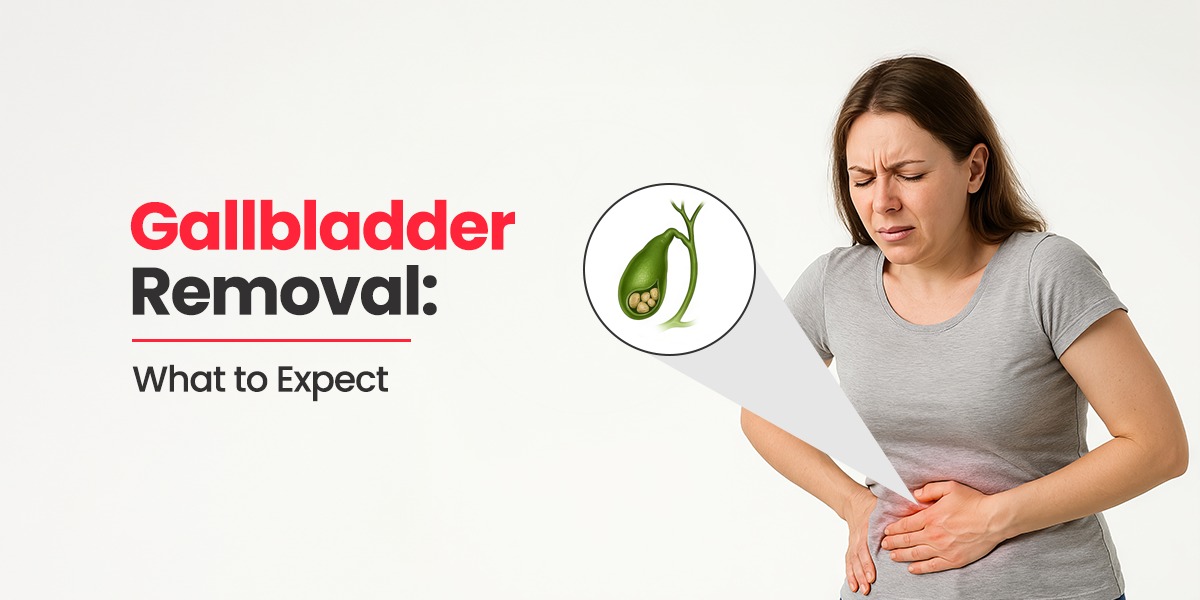Gallbladder Removal Surgery: What to Expect Before, During & After

Surgery isn’t something anyone looks forward to. And when your doctor tells you that you might need your gallbladder removed, it’s natural to feel nervous, confused, or even a little panicked.
But don’t worry, you’re not alone, and more importantly, this isn’t the end of the world. Gallbladder removal is one of the most common surgeries performed today, and for many people, it brings relief from pain and years of digestive discomfort.
This blog walks you through the entire experience. Let us begin!
Why the Gallbladder Causes Trouble?
So, let’s start with the basics: what’s the gallbladder even for? It’s a small organ, kind of like a pouch, sitting right under your liver. Its job is to store bile, a digestive juice your liver makes to help break down fats. Sounds useful, right?
But here’s the thing—sometimes that bile gets too thick or forms stones. These gallstones can block the bile ducts, causing inflammation, intense pain (especially after fatty meals), nausea, and sometimes even infections. If you’ve had that sharp upper right-side pain or sudden digestive problems that knock you off your feet, you know what I’m talking about.
When these symptoms become frequent or severe, doctors often recommend gallbladder removal surgery, also called a cholecystectomy. If you’ve reached that point, don’t feel bad. It’s more common than you think.
Before the Surgery: Tests, Prep & Questions
Once your doctor suspects gallbladder issues, they’ll likely run a few tests. Think ultrasounds, blood work, or maybe a CT scan. These confirm whether you’ve got gallstones, inflammation, or any complications.
You’ll then meet with a surgeon—hopefully a good one. If you’re in North India, it’s worth finding a trusted gastro surgeon in Lucknow who has experience with minimally invasive procedures.
Your pre-surgery instructions might include:
- Not eating or drinking after midnight before surgery
- Stopping certain medications temporarily
- Arranging for someone to drive you home
This is also your time to ask questions. Seriously—ask anything that’s on your mind. Will it be laparoscopic or open surgery? What are the risks? How long will recovery take? What kind of scarring will there be? No question is too silly. It’s your body, after all.
What Happens During the Surgery?
Most gallbladder removals are done using laparoscopy. That means the surgeon makes a few tiny incisions in your abdomen, inserts a camera and surgical tools, and carefully removes the gallbladder. It’s kind of incredible. The procedure usually lasts about an hour or two, and because the cuts are small, recovery is typically faster and less painful than traditional open surgery.
That said, sometimes things get tricky—maybe the gallbladder is severely inflamed or infected—and the surgeon may switch to an open procedure. That involves a larger cut and a slightly longer hospital stay, but it’s still a routine surgery.
You’ll be under general anesthesia the whole time. No pain, no awareness—just a nap you wake up from in the recovery room.
After the Surgery: What Recovery Looks Like
Waking up, you’ll feel groggy and probably a little sore around your belly. That’s normal. Most people go home the same day, but if your procedure was more complex, you might stay overnight.
In the first few days, expect:
- Tiredness and low energy
- Mild to moderate pain (usually managed with over-the-counter meds)
- Gas or bloating (your body’s adjusting)
- Trouble with heavy lifting or bending
Take it easy. Walk a bit each day to keep your blood flowing, but don’t overdo it. Most people return to light activities within a week and go back to work (depending on the job) in about 10–14 days.
What Happens When the Gallbladder Is Removed?
This is a common concern. People wonder, “Can I still eat normal food? Will digestion suffer forever?”
Here’s the deal: when the gallbladder is gone, bile from your liver flows directly into your small intestine. There’s no storage, just a slow trickle. This can mean your body has a harder time digesting large amounts of fat at once, especially at first. That’s why the diet after gallbladder removal becomes so important.
Conclusion
Gallbladder removal isn’t a walk in the park, but it’s also not something to fear. It’s a straightforward procedure with a high success rate. The idea of surgery might make you anxious now, but months from now, you’ll probably look back and feel relieved that it’s behind you.
Just take it one day at a time. Ask questions. Be kind to your body. And don’t rush the recovery. You’ll find your “new normal” soon enough—and it’ll likely be way more comfortable than life with a cranky gallbladder.
If you’re still unsure, schedule a consultation with a skilled gastro surgeon in Lucknow or your city. A good doctor will guide you with compassion and clarity, not pressure.
Also Read: Gastrointestinal Disorders: Causes, Symptoms, Types and Treatments

 Call-an-Ambulance
Call-an-Ambulance



